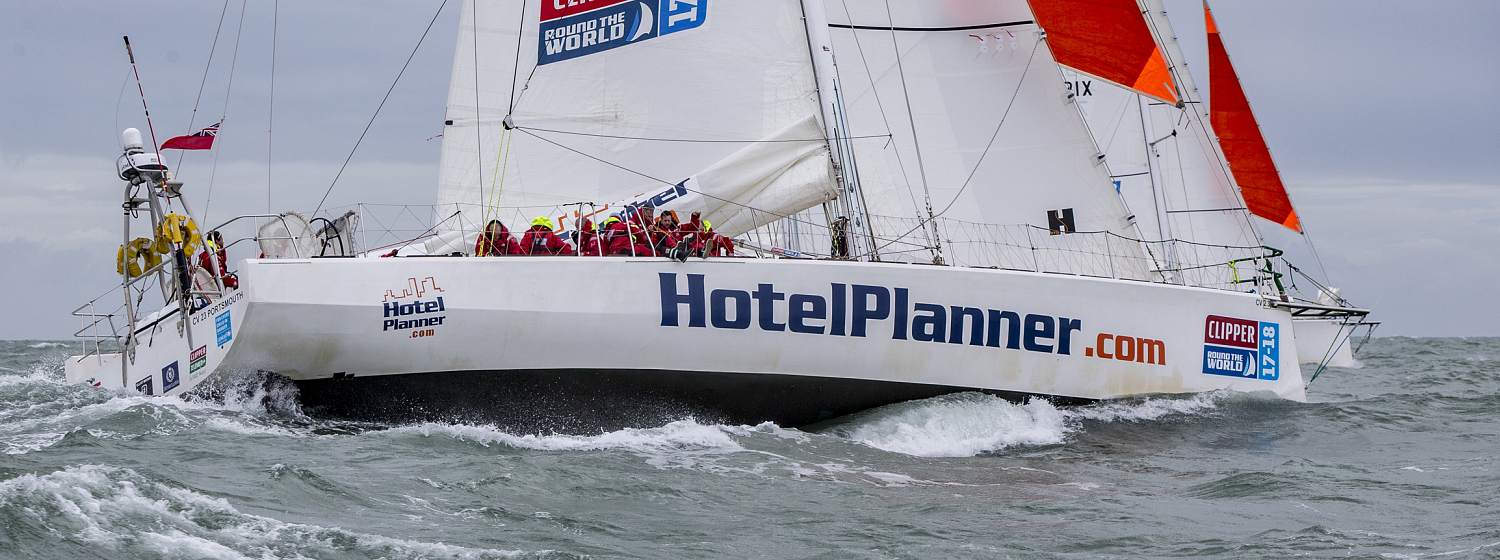Race 2 - Day 10
Crew Diary - Race 2 Day 10: Punta del Este to Cape Town
14 October
Graham Hill
Well, it's been interesting since I last wrote. We have a frontal system slowly moving over us at a speed not much faster than our boat speed so we are stuck with strong winds, low clouds and rain. Top wind speeds gusting over 50kts, average wind mid-thirties but gusting. The apparent wind has been ninety degrees to us, that's on the beam in nautical terms. Our sail plan is the main with three reefs and the Yankee 3. We have dropped the staysail and the helm has been pretty balanced in a rather confused sea. Boat speeds have been good, record so far 23.8kts, and we achieved our target of sailing 303 miles in 24 hours from noon 11 Oct to noon 12 Oct. Great achievement and a target we must strive to beat again. All the helms have had to work very hard with a lot of concentrated effort. The helm can be quite physical and this has certainly proved the case over the last 36 hours.
So, back to sails. I described a couple of days ago the basic set of white sails we have in our wardrobe (Sail Locker - Forward). But these are not the only sails that are going to win this race.
We have four other very important sails.
Three spinnakers, known as Codes 1, 2 and 3. These are asymmetric spinnakers which means that they are not flown from a spinnaker pole but from the bowsprit which extends from the bow of the boat.
The Codes vary in size, Code 1 being the biggest and Code 3 the smallest, and from the summary below you can see they are huge and a very large area is required to carry out the inspection at the end of each leg. They are designed and cut so they can be flown in such a way as to take maximum advantage of the winds that are more from behind the boat. This means when the wind is at an angle of more that 90 degrees from the bow, they need to considered in the sail plan. They are, however, made of much lighter material and are not hanked onto a wire stay so there is an art in keeping them filled without wrapping them around the rigging and tearing them.
You will have read about some of the incidents that have happened in relation to spinnakers so far. Punta del Este's quay had its fair share of spinnakers being laid out and the boat sail repairer and crew busily stitching and tapping tears and holes where required. The other difference with the spinnakers is that they have to be raised in a controlled manner as they are so large. The way this is done is that the each of the three corners of the sail are rolled up and then the rolls have a piece of wool tied around the roll. When the sail is hoisted it should stay held together with the wool until it is in a controllable state before the wind catches it starts to fill it and the wool breaks revealing the spinnaker in its full glory. The route the race follows means there is a fair amount of downwind sailing and with these sails, better boat speed can be achieved. We have seen 20kts so far but understand much higher speeds can be obtained with efficient helming.
It is well worth Googling 'Clipper Asymmetric Spinnakers' and looking at some Clipper YouTube clips to see how they work. Impressive...
Assymetric Spinnakers: these are all made of Fibermax 64 Stabilised Nylon
Code 1: largest, 326 square metres - Maximum Advised Wind Strength up to 12kts apparent wind
(Weight of Nylon 1.5oz)
Code 2: Middle, 322 square metres - Maximum Advised Wind Strength up to 20kts apparent wind
(Weight of Nylon 2.2oz)
Code 3: Smallest, 261 square metres - Maximum Advised Wind Strength up to 30kts apparent wind
(Weight of Nylon 3.4oz)
The last lighter-weight sail is the Windseeker. As its name suggests, it is used in very light winds to seek out the wind and get the boat moving. The boat then generates its own wind when it moves forward and ensures progress is made when there are only a few knots of breeze. This sail is like a spinnaker in so far as it is not hanked up to a wire stay but is cut in such a way to be used in marginal upwind as well as downwind conditions.
Windseeker: 162.5 square metres - Maximum Advised Wind Strength up to 8kts apparent wind
(Weight of Nylon 2.2oz)
Hopefully this has given you a taster of the sails we have to select when deciding on the sail plan once the weather has been analysed.
There are a few more sails we carry and I will summarise these in my next blog.
We are all looking forward to Cape Town, and I am especially looking forward to my wife Sarah joining me, or should it be me joining her. It seems along time since Liverpool...

